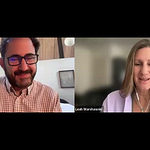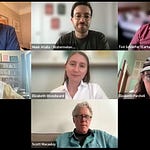But First - Save the Date June 25th 2pm ET
Before we get to the summary of our last week’s webinar, we’d like to announce our June webinar co-sponsored by Filmmaker Magazine profiling four new adventurous distributors that have landed on the US independent scene. Join Scott Macaulay (Filmmaker Magazine) and I, for a conversation with Elizabeth Woodward (Willa), Munir Atalla (Watermelon Pictures), Elizabeth Purchell (Muscle Distribution), and Theodore Schaefer & James Belfer (Cartuna x Dweck).
We’ll explore what new business models these distributors are using in to engage audiences and earn revenue, how are they different and how are they similar to past models, what innovations they are exploring and much more.
June 25th 11amPT/ 2pm ET Stay tuned for a registration link.
Case Study Webinar Summary for 1946 - How Sharon “Rocky” Roggio Built an Audience and Self-Released a Movement
Last week we hosted an 8 Above webinar focused on what it really means to build your audience before you release your film—especially when you’re walking the independent distribution path. We were joined by Sharon “Rocky” Roggio, the director and (uncredited) impact producer behind 1946: The Mistranslation That Shifted Culture, a documentary that made serious waves without a traditional distributor, breaking new ground on Eventive and beyond.
This post recaps the conversation and key takeaways from the webinar. You’ll find practical strategies, honest numbers, and lessons from the field.
1. Why the Traditional System Didn’t Work
Rocky believed 1946 would be a natural fit for Netflix: it had global relevance, academic credibility, and a non-threatening tone. Instead, the film was passed over.
The reality: unless your doc is celebrity-driven, true crime or algorithm-friendly in other ways, most streamers aren’t picking it up. And the deals that are offered for “originals” in general require giving up all rights for 15 to 20 years if not in perpetuity?
So she walked away—and built her own path.
“When the system says no, let your story be an even louder yes.”
2. Start Building Before You Shoot
One of the biggest takeaways: audience building doesn’t start at the release—it starts well before. In the case of 1946 - Sharon began before the first frame was shot:
Identifying and engaging their core audience (faith communities, LGBTQIA+ allies, scholars)
Hosting early Zoom sessions and focus groups
Sending frequent newsletter updates
Turning super fans into ambassadors and volunteers
Leaning into transparency, behind-the-scenes sharing, and feedback loops
By the time the film premiered at DOC NYC, a real community was already in place.
3. Outreach = Funding
From day one, Sharon’s personal outreach was not just about audience building—it was a core fundraising engine.
She reached out directly to potential partners, allies, and community leaders with updates about the project’s progress, its purpose, and why it mattered. These early communications, Zoom calls, and in-person discussions didn’t just help refine the story—they converted. Sharon noted that some of her most meaningful donations came from relationships built in these early-stage touchpoints.
Focus group screenings in part designed for feedback on the edit of the film often doubled as soft fundraising pitches, and consistent, honest updates through email and social helped maintain trust.
This strategy ultimately led to:
A $50K impact grant from Evoke Media
Ongoing individual donations through GoFundMe and fiscal sponsorship
Loans and support from early executive producers
In-kind support and volunteer labor from passionate audience members
Sharon shared on the webinar: “I started just by telling people why this story mattered to me—and people responded.”
4. Eventize Everything
Every screening was treated as an event—not just a showing. This included:
Local partnerships with churches and advocacy orgs
Watch parties (500+ across 25 countries)
In-person Q&AsLimited virtual windows with urgency and exclusivity
This strategy paid off big, particularly through their partnership with Eventive.
“Don’t just make it available—make it matter.”
5. The Financial Breakdown
Rocky and team were refreshingly open about the money. Here’s what they shared:
Virtual Screenings (Eventive):
$118,000 in net revenue
Over 6,000 single-ticket sales
500+ watch parties
Maintained all rights and viewer data
Top 5 Eventive film of 2023
Theatrical Strategy:
Ran their own Oscar/BAFTA-qualifying theatrical in LA, NY, and London
Total cost: ~$75,000 (covered by grants, EP loans, and ticket sales)
$54,000 went to the publicity firm.
Impact Campaign:
Separate $50K grant from E. Rhodes Leona B. Carpenter Foundation and a separate $15k grant (split between 2023 and 2024) from Evoke Media + ongoing grassroots fundraising
Tools included a workbook, podcast, educator guide, and resource hub
No traditional distribution. No aggregator. 100% control retained.
6. Social Media: The Long Game
Rather than just “posting,” the 1946 team focused on platform-specific, community-first engagement:
Built new social handles (@1946themovie) rather than relying on personal accounts
Prioritized TikTok (201K+ followers) and Instagram (49.3K+)
Posted daily—no automation
Used targeted hashtag clusters (community, location, topic-based)Partnered with influencers and orgs for shared reach
Sharon’s rule: treat your audience like humans, not numbers.
7. What They’d Do Differently
Start even earlier: especially ambassador programs and educator outreach
Rethink PR timing: hiring a publicist helped, but ROI varied
Double down on community screenings: these offered the best conversion from engagement to action
Everyday donors > chasing whales: small recurring support fueled the campaign, GoFundMe is still open to this day!
Final Takeaway
This isn’t just a case study in clever marketing. It’s a playbook for impact producers, filmmakers, and anyone navigating a broken distribution landscape.
1946 didn’t just build an audience—it activated one.
And they did it all by staying close to the community, trusting their voice, and refusing to wait for permission.
Materials:
Sharon’s presentation deck is available here.
The videos she referenced produced by Evoke Media are here.
Eventive published a case study.









